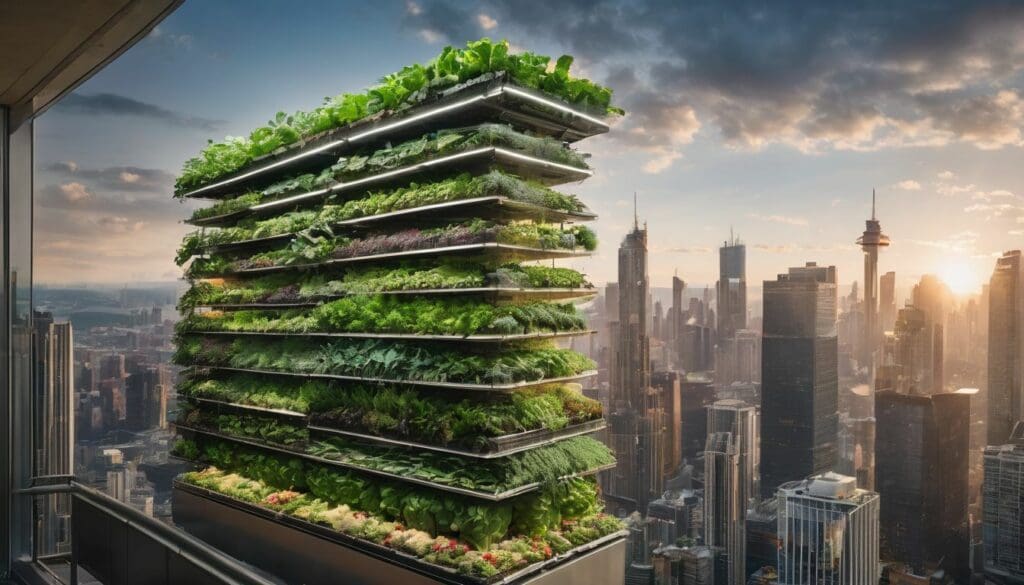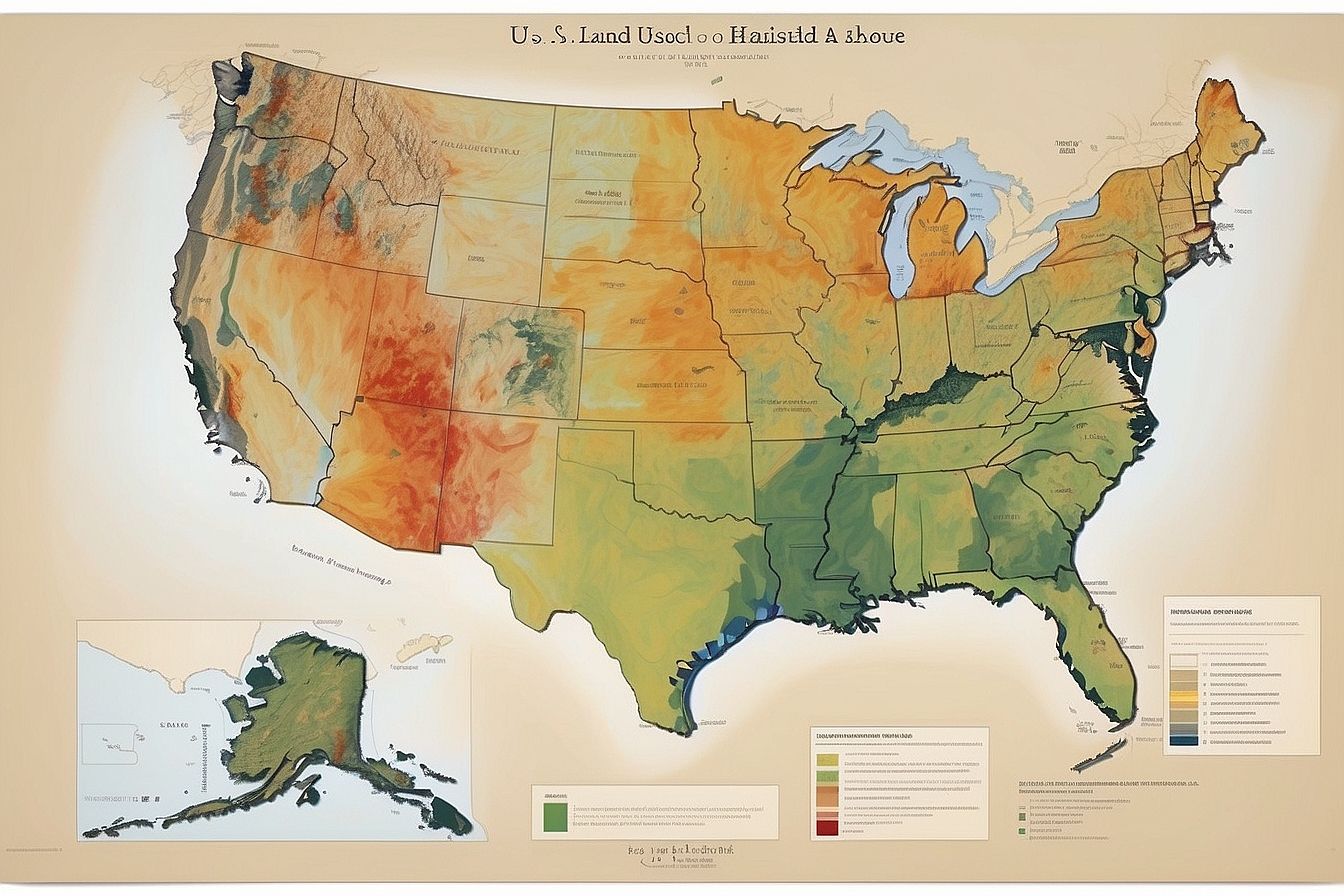Access to fresh, healthy food is a pressing issue that resonates deeply with many of us living in the heart of our vibrant cities. Amidst the hustle and bustle, finding grocery stores stocked with genuine nourishment can be surprisingly challenging.
We share your concerns; it’s disheartening to observe urban spaces fall prey to becoming food deserts where residents find themselves over 10% short of having access to fresh produce within a mere half-mile radius.
Fortunately, our insights into vertical farming shine as a ray of hope amidst this backdrop. Imagine transforming towering high-rises into lush, verdant gardens – an initiative that has the potential to completely redefine metropolitan lifestyles by bringing farm-fresh foods right to your doorstep.
Let’s delve into these green solutions that are not just reaching, but thriving in the skies above us!
Key Takeaways
- Vertical farming utilises stacked layers to grow crops, turning urban high-rises into efficient food-producing spaces that maximise limited space in cities.
- By controlling the indoor climate, vertical farms provide a steady supply of fresh produce year-round, which is crucial for communities in food deserts where access to healthy food is scarce.
- This farming method uses less water and minimises the need for harmful pesticides, making it an eco-friendly option that can lead to healthier urban environments.
- Incorporating advanced technologies helps vertical farms manage resources efficiently, improving crop quality and yield while reducing waste and overall environmental impact.
- Localised production through vertical farming reduces transport emissions and contributes to sustainability by providing fresh produce directly within urban areas affected by food scarcity.
What is a Food Desert?
We often hear the term ‘food desert‘, but what exactly does it mean? Simply put, a food desert is an area where residents find it tough to buy affordable, good-quality fresh food. This can be because there are no supermarkets or grocery stores nearby.
Imagine living in a place where even basic fruits and vegetables are hard to come by or too expensive to regularly include in your meals.
Food deserts typically crop up in low-income neighbourhoods where people may not have access to transport. It becomes a daily challenge for families to maintain a nutritious diet, which can lead to serious health issues like obesity or diabetes.
These areas lack the arable land needed for traditional farming methods that could provide fresh produce locally—forcing communities to rely on processed foods that are readily available but far less beneficial.
Embracing solutions like vertical farming holds great potential for transforming these urban agriculture deserts into oases of food security and sustainability. Moving forward, let’s explore how vertical gardening might just change the face of urban food accessibility.
The Potential of Vertical Farming
Traditional farming methods face challenges such as limited space, unpredictable weather, and soil degradation. However, vertical farming offers a solution by utilising indoor spaces to grow crops in a controlled environment.
This innovative approach can significantly impact urban food deserts by providing consistent crop production and increasing food accessibility in low-income communities.
Challenges of Traditional Farming
Traditional farming faces several challenges. Pests and diseases often harm crops, leading to reduced yield. Additionally, adverse weather conditions like droughts or floods can devastate harvests, impacting food production.
Furthermore, traditional farming methods require significant land space, which may not be viable in urban areas with limited land availability.
Moreover, the reliance on chemical pesticides and fertilisers in conventional agriculture poses environmental risks such as soil degradation and water pollution. The high cost of these inputs also adds financial strain for farmers, especially those in low-income communities.
Advantages of Vertical Farming
After discussing the challenges of traditional farming, it’s important to consider the advantages of vertical farming. This innovative approach offers numerous benefits that can make a significant impact on urban food deserts and food insecurity in low-income communities. Here are some key advantages to consider:
- Maximised Use of Space: Vertical farming optimises land use by growing crops in stacked layers, allowing for higher crop yield in smaller areas.
- Reduced Water Usage: Utilising hydroponic or aeroponic systems, vertical farms consume significantly less water compared to traditional farming methods, addressing issues of water scarcity.
- Climate Control: Controlled indoor environments enable year-round production, independent of external weather conditions, ensuring consistent crop supply.
- Sustainable Practices: Vertical farming reduces the need for pesticides and herbicides while also minimising transportation emissions due to localised production.
- Technology Integration: Incorporating cutting-edge agricultural technology enables precise monitoring and efficient resource management, leading to improved crop quality and yield.
Impact on Urban Food Deserts
Vertical farming has the potential to address food deserts in urban areas by providing a sustainable source of fresh produce. By utilising indoor farming technology, communities can have access to locally grown fruits and vegetables, even in low-income areas.
This can significantly improve food security and nutrition for residents living in urban food deserts.
Community gardens and vertical farming initiatives can also promote environmental conservation by reducing the need for long-distance transportation of produce. Additionally, the use of technology in farming allows for efficient resource management, making it a practical solution for addressing food deserts while supporting conservation efforts.
Conclusion
In conclusion, vertical farming offers a promising solution for urban food deserts. It addresses the challenges of traditional farming and provides fresh produce to low-income communities.
With its potential to transform underutilised urban spaces into productive farms, vertical farming can make a significant impact in addressing food insecurity. Community gardens and environmentally conscious individuals are vital in supporting this innovative approach to sustainable food production.
FAQs
1. What is vertical farming?
Vertical farming is a way of growing food in stacked layers, often indoors, which can bring fresh produce to urban areas where space is limited.
2. How does vertical farming help low-income communities?
It offers a reliable source of nutritious food by setting up close to or inside urban neighborhoods that lack access to fresh groceries.
3. Can vertical farms be as productive as traditional farms?
Yes, they can be highly productive using less land and water, making them ideal for city environments where these resources are scarce.
4. Do community gardens work like vertical farms?
Community gardens share similar goals with vertical farming by providing local food sources but usually exist outdoors and on a single level rather than being stacked.





